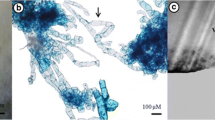Summary
Germ-pore-containing ovule sections, excised from data palm (Phoenix dactylifera) fruit 2 to 3 months after pollination, produced callus in a medium enriched with 2,4-D. Reculture of callus in auxin-less medium resulted in development of numerous asexual embryos. Callus development and asexual embryogenesis also were observed inHoweia forsteriana andChamaedorea costaricana embryo explants, although not as profusely as inP. dactylifera.
Similar content being viewed by others
References
Corner, E. J. H. 1966.The Natural History of Palms. University of California Press, Berkeley and Los Angeles.
Reuveni, O., and H. Licien-Kipnis. 1974. Studies of the in vitro culture of date palm (Phoenix dactylifera L.) tissues and organs. Volcani Inst. Agric. Res. Pamphlet No. 145, pp. 3–39.
Eeuwens, C. J., and J. Blake. 1977. Culture of coconut and date palm tissue with a view to vegetative propagation. Acta Hortic. 78: 277–286.
Eeuwens, C. J. 1978. Effects of organic nutrients and hormones on growth and development of tissue explants from coconut (Cocos nucifera) and data (Phoenix dactylifera) palms cultured in vitro. Physiol. Plant. 42: 173–178.
Ammar, S., and A. Benbadis. 1977. Multiplication végétative du palmier-dattier (Phoenix dactylifera L.) par la culture de tissue de jeunes plantes issues de semis. C. R. Acad. Sci. Ser. D 284: 1789–1782.
Rabéchault, H., J. Ahée, and G. Guénin. 1970. Colonies cellulaires et formes embryoides obtenues in vitro á partir de cultures d'embryons de palmier á huile (Elaeis guineensis Jacq. var. dura. Becc.). C. R. Acad. Sci. Ser. D 270: 3067–3070.
Jones, L. H. 1974. Propagation of clonal oil palm by tissue culture. Oil Palm News 17: 1–9.
Corley, R. H. V., J. N. Barrett, and L. H. Jones. 1977. Vegetative propagation of oil palm. In: D. A. Earp, and W. Newell (Eds.),International Developments in Oil Palm;Proceedings of the Malaysian International Agricultural Oil Palm Conference. Inc. Soc. of Planters, Kuala Lumpur, pp. 1–8.
Berlyn, G. P., and J. P. Miksch. 1976.Botanical Microtechnique and Cytochemistry. The Iowa State University Press, Ames, Iowa.
Brelyn, J. G. 1966. The initiation of organized development in plants. Adv. Morphol. 5: 39–91.
Esan, E. B. 1973. A detailed study of adventive embryogenesis in the Rutaceae. Ph.D. thesis, University of California, Riverside.
Tisserat, B. H. 1976. A factor in citron that represes asexual emryogenesis in citrus and Daucus tissues in vitro. Ph. D. thesis, University of California, Riverside.
Author information
Authors and Affiliations
Additional information
The research wa supported in part by NSF Grant OIP 75-10390, the Elvenia J. Slosson Fellowship in Ornamental Horticulture, and grants-in-aid from Keeline-Wilcox Company, Irvine, California, and Dr. Donald Shields of Brea, California. Plant materials also were provided by the Keeline-Wilcox Company, Dr. Donald Shields, and the U.S. Data and Citrus Station, Indio, California.
Rights and permissions
About this article
Cite this article
Reynolds, J.F., Murashige, T. Asexual embryogenesis in callus cultures of palms. In Vitro 15, 383–387 (1979). https://doi.org/10.1007/BF02616146
Issue Date:
DOI: https://doi.org/10.1007/BF02616146



